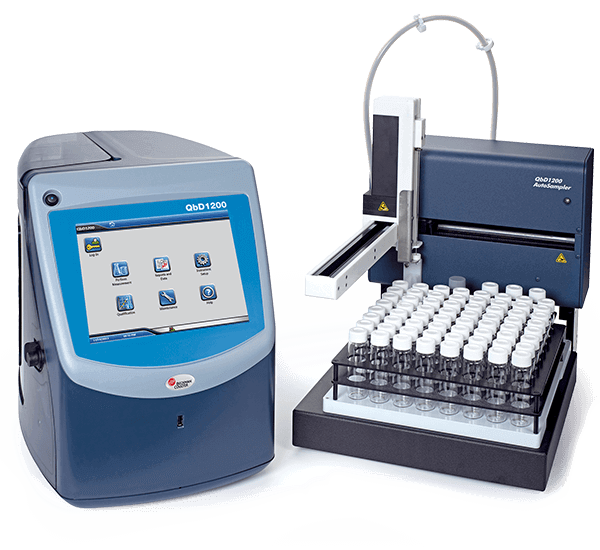Water Release Testing for GMP Manufacturing

Pharmaceutical manufacturing requires many raw materials to produce drugs. Water is probably the largest raw material used by the bio/pharmaceutical manufacturing industry. The quality of the water used in manufacturing is defined by the global Pharmacopoeias who have harmonized the parameters and requirements for Purified Water (PW) and Water for Injection (WFI).
Pharmacopeias require PW and WFI water to pass 4 critical quality parameters1:
- Total organic carbon (TOC)
- TOC is a measure of the organic material in the water which is food for microbes. Excess TOC levels allows microbes to thrive and proliferate. TOC usually comes from the remains of microbes that have passed through the filtration process
- QbD1200 and PAT700
- Conductivity
- Conductivity measures residual inorganics that could remain in the water post-treatment, such as chlorine, which is added to drinking water to control microbial growth.
- PAT700 from Beckman Coulter can measure both TOC and Conductivity on line in the water treatment plant
- Microbial Contamination
- It’s almost impossible to get rid of all microbes, so the goal is to prevent them proliferating in the water system. TOC measurement isn’t a measure of microbes, it’s a measurement of the organic material in the water that could be food for microbes. The goal is to keep the organic material down so microbes can’t proliferate.
- Typical methods for sterilizing the water to reduce microbial growth are heat and ozone. The International Society for Pharmaceutical Engineering (ISPE) guide to Ozone Sanitization of Pharmaceutical Water Systems contains guidance on the use of ozone for microbial control in water systems.2
- Endotoxins in the water
- Endotoxins are substances found in the cell walls of microbes. Microbes are in the drinking water used as the starting material for PW and WFI manufacturing. This water is sterilized by filtration. Microbes are shredded as they go through the filter, which kills them. However, parts of the cell wall of the microbes containing endotoxin material pass through into the water system.
- It could be dangerous for a patient if endotoxins were injected as part of a medicinal product. Frequently these patients have compromised immune systems, so this could be detrimental to their health. These endotoxins need to be closely controlled for patient safety by ensuring they’re removed from purified water used in drug manufacturing.
Two water types are used in bio/pharmaceutical manufacturing
- Purified water (PW)
- Purified is derived from drinking water passed through various filtration and treatment steps. It’s used by both biopharmaceutical manufacturing and chemically-derived small molecule pharmaceutical companies working making injectables, powders or tablets. Purified water must meet the 4 critical quality parameters defined above to be used in manufacturing.
- Pharmacopoeial requirements for PW production include1:
- Must meet requirements for ionic and organic chemical purity, and be protected from microbial contamination
- Source water treatment steps can include deionization, distillation, reverse osmosis or other suitable purification process
- Purified water systems must be validated to ensure they reliably/consistently produce water of acceptable quality even with the seasonal variations of incoming drinking water quality
- Systems operated under ambient temperature conditions require monitoring and frequent sterilization to control microbial levels
- Water for Injection (WFI) –
- Water for injection is purified water taken through additional treatment steps. It's used for injectable drugs, including all biologically derived pharmaceutical product as well as small molecule chemically derived products that are delivered by injection. A biopharmaceutical product delivered by injection into the body requires an extra level of cleanliness because it bypasses the body's natural protection and goes straight into the bloodstream or tissue.
- There should be no microbial contamination in the final product. When filling syringes for injection, the material is typically passed through a 0.2 micron filter to again shred any microbes coming through to ensure purity. Injectable drugs are manufactured in clean room environments to reduce potential contamination from the air and the production staff.
- Pharmacopoeial requirements for WFI production include1:
- WFI must meet all requirements for Purified Water—plus specifications for bacterial endotoxins prone to inhabit water
- Tests for total organic carbon (TOC) and water conductivity apply to WFI produced onsite for use in manufacturing
- Levels for WFI in USP <1231> (10 cfu/100 mL) are considered to represent a level above which the water is unfit for use
- On-line testing for conductivity and TOC can avoid contamination risks and provide immediate analysis and opportunities for real-time control/intervention
References
- USP Chapter <1231> Water for Pharmaceutical Purposes, United States Pharmacopeial Convention – National Formulary (USP-NF), www.usp.org/usp-nf
- Good Practice Guide: Ozone Sanitization of Pharmaceutical Water Systems, ISPE. July, 2012. https://ispe.org/publications/guidance-documents/ozone-sanitization-pharmaceutical-water-systems
Products and methods described are not intended for use in diagnostic procedures.
Water Release Testing Products

ANATEL PAT700
The ANATEL PAT700 is a total organic carbon analyzer for on-line release testing for Conductivity and TOC Analysis


